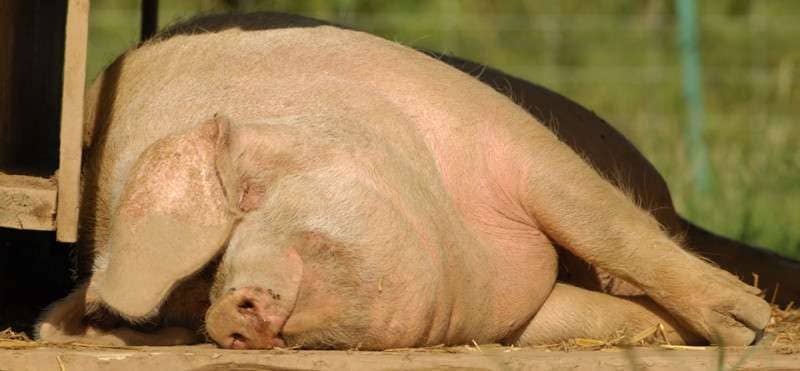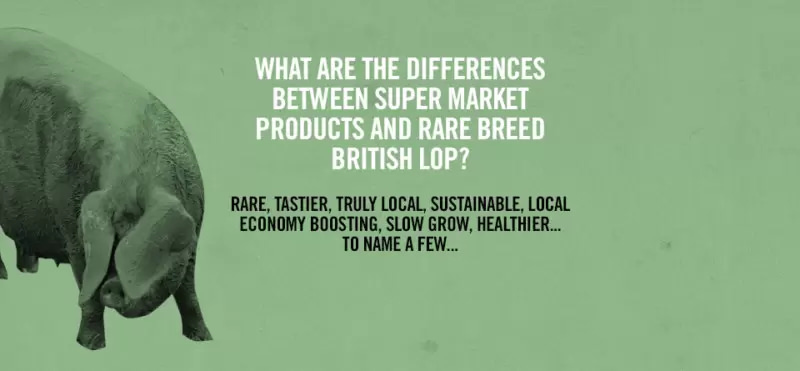This pig — named for its large ears which hang over its face — is a descendant of the original lop-eared, white pigs associated mainly with the Celtic areas in Great Britain and that lived and bred in the farmyards of the south-west of England, for centuries. These pigs, whilst an amalgamation of several local English lop-eared breeds, still managed to avoid much of the country-wide trend of using imported Asian breeds for improvement and remained a breed well suited to surviving on very little and making use of otherwise unproductive land.

It was first recognised in the Tavistock area, where it was called the Devon Lop, or sometimes the Cornish White pig. It spread throughout the south-west of the country, as far as Somerset and Dorset, but was rarely seen beyond that vicinity.¹
It is however closely related to similar breeds found around the north-western fringes of Europe, namely the Welsh, and the Landrace pig breeds of Scandinavia. And it’s been suggested that it may also be related to the Normande pigs of France.²
The British Lop suffers in the “rare breed” stakes by not looking particularly distinctive. It is, after all, as its earlier name says, merely a “white lop-eared pig” and to the non-specialist, could be easily confused with the Welsh or the Landrace. Instead, many enthusiasts flocked to pigs with short snouts, spotted or ginger hogs but not so readily to this pig that looked quite normal.
The pig’s head should be of medium length and wide and smooth, with long, thin ears that blinker the eyes. Its back is long & level with wide shoulders; it has a wide strong loin and broad, deep hams. The tail is set on high. The body is deep with well-sprung ribs. Medium-length legs should be straight and level with strong pasterns. The skin is pure white with long, silky hair.⁴
The breed society was formed in 1918 — originally under the name of the National Long White Lop-Eared Pig Society — the name was then changed to the British Lop Pig Society in the 1960s and they keep their own, independent herd book.
At the end of the war in 1945, the UK decided that they needed to maximise food production. Thus the 1947 Agricultural Act was passed and stated:
The twin pillars upon which the Governments agricultural policy rests are stability and efficiency.
As with most of the other rare breeds that have disappeared, this change of emphasis, together, a little while later with the hugely momentous decision made following the recommendation of the Howitt report to the government in October 1955, to concentrate pig production on just three, more commercially viable breeds (the Landrace, the Large White and the Welsh) was disastrous for the British Lop.
In the first place we have formed the view that one of the main handicaps facing the British pig industry today is the diversity of the type of pig which is found throughout the country. The pig industry will in our view only make real progress when it concentrates on a few main types and – if it were at any time found possible – on a single type of pig for commercial production.
It is from these three breeds that we would hope to see developed through intensive progeny testing in the coming years the improved bacon pig which would provide boars for use by nearly all commercial breeders for bacon and pork. The importance and urgency of this task cannot be overstated. (Sir Harold Howitt)
Numbers dropped precipitously and that fall, coupled with the breed’s relative confinement to a handful of farmers in and around the Cornwall/Devon border, meant that the Lop became very rare (so much so, that (the late & sadly missed) Clarissa Dickson Wright, a huge fan of the breed was moved to comment that “The British Lop is rarer than the Giant Panda”).³ Whilst quite an accurate claim, their breeding abilities are, luckily, substantially better than these Chinese inhabitants, as the dams are prolific and make good, milky mothers.
The breed today is still quite rare (it’s deemed to be of “vulnerable” status by the Rare Breeds Survival Trust) and, whilst there are now herds throughout the country (with an enclave in Warwickshire and a large herd in Berwickshire) again, like the Mangalitsa, this doesn’t necessarily guarantee their survival — commercial imperatives mean that the marginal costs involved in rearing and feeding these (often slower maturing) breeds are similar or higher than the “force bred” variants whilst the return on investment is thus considerably lower. Many breeders run their herds at a net loss.
The breed does have a reputation for prolificacy and litters of 12-14 are normal. The sows have excellent maternal instincts. The boars have been used to great effect on other breeds as a terminal sire (“a boar used on a cross-bred sow”). In size, a large sow would weigh around 325-350lb, whilst boars can come in between 375lb and up to 400lb. Despite their size, they have a generally placid temperament and are easily managed. As a pure breed pig, they are ideal for meat at porker, cutter or bacon weight. And as a slow reared pig and economical feeder, this means a good balance of intramuscular fat which gives a moist and creamy textured pork as well as rashers with a large eye muscle of meat.
A daily live weight gain of 0.45kg and a killing out percentage of around 80% is achievable. An extensively reared pork pig (70-75kgs) can be ready for slaughter within 160-170 days
¹ Some very useful content courtesy The British Lop Pig Society site, inc. the lovely Lop photo above — a wonderfully enthusiastic group of people dedicated to this fine breed
² Alderson, R. (1994). Rare Breeds. Laurence King Publishing. ISBN 1-85669-052-0.
³ “Interview: Clarissa Dickson Wright, chef”. The Scotsman. 13 March 2011
⁴ From the gorgeously photographed (Andrew Ferris) “Beautiful Pigs” written by Andy Case. ISBN 978-0-7112-3059-0
⁵ The Rare Breeds Survival Trust
